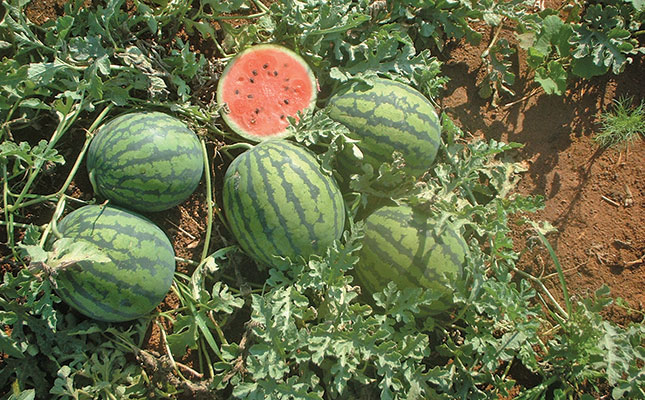
Photo: Bill Kerr
Since the spread of the species around the globe, much breeding has taken place to improve the eating quality and yield, and to provide different sizes for individual preferences and markets.
In addition, pink-, orange- and yellow-fleshed varieties are now available, but these have not been well accepted in South Africa.
In most parts of the world, the trend has been towards smaller fruits, possibly for the convenience of fitting them into a refrigerator. These are referred to as ‘icebox types’.
They mature earlier, enabling the farmer to get them onto the market sooner and so obtain a higher price.
Many supermarkets cut the large fruit into smaller sizes for convenience. This has the added advantage of allowing the customer to see the quality of the flesh, reducing the risk of getting an over- or under-ripe fruit. (The cut fruit has a shorter shelf life, so should be wrapped in cling film and refrigerated.)
Seedless varieties
Seedless watermelons came onto the market fairly recently. However, the seed is very expensive and the rand’s weak exchange rate pushes up the price even more. The crop is also more difficult to produce. For these reasons, growth of the seedless watermelon market in South Africa has been slower than elsewhere.
Seedless watermelons are often referred to as ‘triploid watermelons’. The question invariably asked is how a farmer can reproduce seedless melons when they are, well, seedless.
A normal diploid watermelon has 22 chromosomes comprising two sets. These divide into two, so that the egg and pollen each have one set of thread-like chromosomes. These are called haploids and combine at fertilisation to total 22 chromosomes.
To produce a triploid, breeders chemically treat a parent to double its chromosomes, giving rise to four threads totalling 44 chromosomes (a tetraploid). When crossed with a diploid, the result is three sets of threads, or 33 chromosomes, which is ‘unnatural’.
As no viable pollen is produced, the fertilised egg cannot develop and the seeds will not be fully formed.
The much higher cost of seed and difficulty with germination means that a farmer will have to get a substantially higher price for the product to justify growing it.











